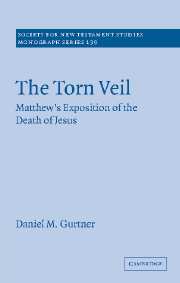Book contents
- Frontmatter
- Contents
- Preface
- List of abbreviations
- 1 Introduction
- 2 Veils in the Old Testament
- 3 Functionality and Identity of the ‘Veil of the Temple’
- 4 The Veil in Second Temple and Rabbinic Judaism
- 5 Matthew's Temple and Jesus' Death: Hermeneutical Keys to the Rending of the Veil
- 6 Analysis of the Matthean Velum Scissum Pericope
- Conclusion: Matthew's velum scissum – Retrospect and Prospect
- Diagram: Veil Language in the Structure of the Tabernacle
- Appendix 1 Veil Language in the Old Testament
- Appendix 2 Veil Language in the Two Tabernacle Accounts
- Appendix 3 Kαταπέτασμα and the חכרפ
- Bibliography
- Index of Texts
- Index of Select Subjects
- Index of Modern Authors
- Index of Select Terms
2 - Veils in the Old Testament
Published online by Cambridge University Press: 22 September 2009
- Frontmatter
- Contents
- Preface
- List of abbreviations
- 1 Introduction
- 2 Veils in the Old Testament
- 3 Functionality and Identity of the ‘Veil of the Temple’
- 4 The Veil in Second Temple and Rabbinic Judaism
- 5 Matthew's Temple and Jesus' Death: Hermeneutical Keys to the Rending of the Veil
- 6 Analysis of the Matthean Velum Scissum Pericope
- Conclusion: Matthew's velum scissum – Retrospect and Prospect
- Diagram: Veil Language in the Structure of the Tabernacle
- Appendix 1 Veil Language in the Old Testament
- Appendix 2 Veil Language in the Two Tabernacle Accounts
- Appendix 3 Kαταπέτασμα and the חכרפ
- Bibliography
- Index of Texts
- Index of Select Subjects
- Index of Modern Authors
- Index of Select Terms
Summary
Introduction
While many scholars have rightly looked to the Old Testament to explain Matthew's resurrection narrative in 27:53, few have granted the same favour to his veil account in 27:51a. Lange and Schaff declare, ‘There is neither a prophecy of the Old Testament, nor a Jewish popular belief, which could explain a myth in this case.’ Perhaps, then, it is this fact, coupled with lexical ambiguity regarding Matthew's καταπέτασμα τοῦ ναοῦ, that has caused synoptic scholars to look either to Mark or Second Temple Jewish texts (Philo and Josephus in particular, whom I will consider in chapter 4) for explanations of the rending of Matthew's veil. We will see, though, that while lexical evidence shows us there are three curtains translated καταπέτασμα in the LXX, syntactical and functional evidence are decisive factors in determining which of those three is referred to by Matthew.
The key term for which we must account, καταπέτασμα, is found first and most abundantly in Greek Old Testament traditions of the tabernacle. It is largely agreed that at least the general framework of both the first and second temples was patterned after the layout of the tabernacle. Ideologically, Second Temple texts made very smooth and natural transitions from Old Testament tabernacle texts to their respective discussions of either the Second Temple itself or the idealised, heavenly counterpart of the first. This transition itself seems to have Old Testament precedents. R. E. Friedman has suggested that in 2 Chron.
- Type
- Chapter
- Information
- The Torn VeilMatthew's Exposition of the Death of Jesus, pp. 29 - 46Publisher: Cambridge University PressPrint publication year: 2006



